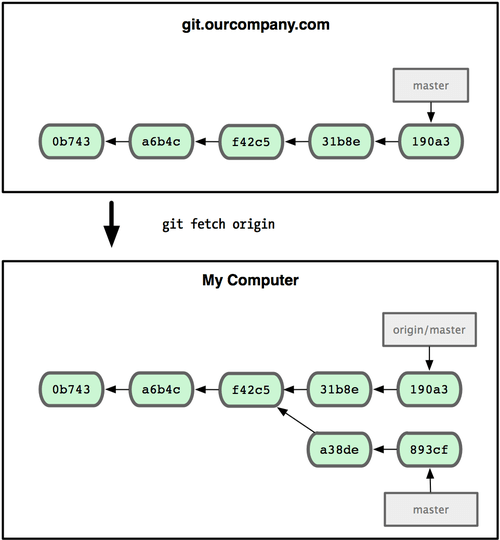

When you are developing a new feature, you are most of the time doing it on your own branch. Most of the time, you want to stick with the first method, meaning using only two dots in order to compare two branches. So which method should you use in order to compare two branches? Using “git diff” with three dots compares the top of the right branch (the HEAD) with the common ancestor of the two branches.Īs always, a diagram speaks a hundred words, so here is the description of the diff command with three dots. So what’s the difference with the previous command? In order to compare two branches, you can also use the “git diff” command and provide the branch names separated by three dots. Comparing two branches using triple dot syntax
#UPDATE MY BRANCH WITH MASTER GIT CODE#
Git is using a color code in order to display differences done between two branches : lines in green are lines added to the files and lines in red are the ones that are deleted from the files. $ git diff master.featureĪs you can see, one file has been added to the branch. In order to see what has been modified between master and feature, you would run the following command. Let’s say for example that you are looking to see the differences between a feature branch (being one commit ahead of master) and the master branch. Instead delete the feature/refactor branch if it is not used anymore.In short, it will show you all the commits that “branch2” has that are not in “branch1”. If you want to continue working on the feature/refactor branch you can merge the feature/refactor branch with master. Notice that the feature/refactor branch is not changedīy this merge. Select the branch to merge with then click the Merge button.Īfter the merge the commit log will show the new commit containing the merge. In the merge dialog you can verify which branch you are working on. Alternatively choose Merge branches from the Commands menu and select the feature/refactor branch. Once we are on the master branch, select the feature/refactor branch and select merge. To merge the feature/refactor branch into the master branch, we first need to switch to the master branch. Master into our branch, but cannot make any change to the master branch. If we do this, the feature/refactor branch will be up to date with the master branch, but not the other way around.Īs long as we are working on the feature/refactor branch we cannot touch the master branch itself. We can merge the commits from the master branch In the image below there are two branches, and. Use caution with this option as Git has no record of uncommitted changes so they cannot be retrieved. Your local changes are discarded and the new branch is checked out. You can retrieve your changes on the new branch with stash-pop. Your local changes are stashed and the new branch is checked out. Performs a three-way merge between your current branch, your local changes and the branch you are checking out. Local changes will be retained if there are not conflicting changes from the branch you are checking out. If you do not clean your working directory then, in the Checkout branch dialog, youĬan choose between four options for your local uncommitted changes: Don't change Overwritten so it is best practice to make sure your working directory is clean by either committing or stashing any currentĬhanges before checking out a branch. Uncommitted changes in the working directory can be Checking out a branch sets the currentīranch and updates all of the source files in the working directory. You can switch from the current branch to another branch using the checkout command. In Git you can refer to your current branch or commit by the special reference HEAD in place of the Git Extensions will show (no branch) in place of a branch name in the toolbar. You are not currently on a branch because you have checked out a specific commit but not any particular branch then In the commit log the current branch has an arrow head to the left of its name. You can switch to another branch byĬhoosing from the combo box list. You can see the name of your current branch in a combo box in the toolbar. The image on the right illustrates a branch created on top of commit B.


Parallel branch or appear as a continuous single line of development as if the branch had never existed in the first When the feature isĬomplete the branch can be merged or rebased as you choose such that the commits for the feature either remain as a Start working on a feature to keep the work done on that feature separate from other work. It is very common to create a new branch when you Branches are used to commit changes separate from other commits.


 0 kommentar(er)
0 kommentar(er)
